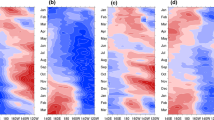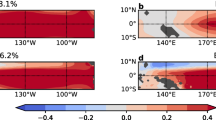Abstract
In this study, the retrospective predictions of ENSO (El Niño and Southern Oscillation) were performed for the period from 1881 to 2000 using a hybrid coupled model, which is an ocean general circulation model coupled to a linear statistical atmospheric model, and using a newly developed initialization scheme of SST assimilation by Ensemble Kalman Filter. With the retrospective predictions of the past 120 years, some important issues of ENSO predictability (measured by correlation and RMSE skills of NINO3 sea surface temperature anomaly index) were studied including decadal/interdecadal variations in ENSO predictability and the mechanisms responsible for these variations. Emphasis was placed on investigating the relationship between ENSO predictability and various characteristics of ENSO system such as the signal strength, the irregularity of periodicity, the noise and the nonlinearity. It is found that there are significant decadal/interdecadal variations in the prediction skills of ENSO during the past 120 years. The ENSO events were more predictable during the late nineteenth and the late twentieth centuries. The decadal/interdecadal variations of prediction skills are strongly related to the strength of sea-surface temperature anomaly (SSTA) signals, especially to the strength of SSTA signals at the frequencies of 2–4 year periods. The SSTA persistence, dominated by SSTA signals at frequencies over 4-year periods, also has a positive relationship to prediction skills. The high-frequency noise, on the other hand, has a strong inverse relationship to prediction skills, suggesting that it also probably plays an important role in ENSO predictability.









Similar content being viewed by others
Notes
The correlation was calculated using samples of 20-year period, thus the criteria of its statistical significance would be 0.22 at the confidence level of 95% if the samples used were independent. However, due to a high persistence, the Pacific SSTA is of non-zero trend and autocorrelated time series, serial correlation must be considered when a statistically significant test is performed (Ebisuzaki 1997).
References
Balmaseda MA, Davey MK, Anderson DLT (1995) Decadal and seasonal dependence of ENSO prediction skill. J Clim 8:2705–2715
Barnett TP, Pierce DW, Saravanan R, Schneider N, Dommenget D, Latif M (1999) Origins of midlatitude Pacific decadal variability. Geophys Res Lett 26:1453–1456
Battisti DS, Hirst AC (1989) Interannual variability in the tropical atmosphere–ocean system: influence of the basic state, ocean geometry, and nonlinearity. J Atmos Sci 46:1687–1712
Blanke B, Neelin JD, Gutzler D (1997) Estimating the effect of stochastic wind stress forcing on ENSO irregularity. J Clim 10:1473–1486
Chang P, Ji L, Wang B, Li T (1995) Interactions between the seasonal cycle and El Niño–Southern Oscillation in an intermediate coupled ocean–atmosphere model. J Atmos Sci 52:2353–2372
Chang P, Giese BS, Ji L, Seidel HF (2001) Decadal change in the south tropical Pacific in a global assimilation analysis. Geophys Res Lett 28:3461–3464
Chen D, Zebiak SE, Busalacchi AJ, Cane MA (1995) An improved procedure for El Niño forecasting. Science 269:1699–1702
Chen D, Zebiak SE, Busalacchi AJ, Busalacchi AJ (1997) Initialization and predictability of a coupled ENSO forecast model. Mon Weather Rev 125:773–788
Chen D, Cane MA, Kaplan A, Zebiak SE, Huang DJ (2004) Predictability of El Niño over the past 148 years. Nature 428(6984):733–736
Deng Z, Tang Y, Zhou X (2007) Reconstruction of historic wind stress over tropical Pacific for 1856–1947
Deng Z, Tang Y, Zhou X (2008) The retrospective prediction of ENSO from 1881–2000 by a hybrid coupled model: (I) SST assimilation with Ensemble Kalman Filter
Ebisuzaki W (1997) A method to examine the statistical significance of a correlation when the data are serially correlated. J Clim 10:2147–2153
Eckert C, Latif M (1997) Predictability of a stochastically forced hybrid coupled model of El Niño. J Clim 10:1488–1504
Flügel M, Chang P, Penland C (2004) The role of stochastic forcing in modulating ENSO predictability. J Clim 17:3125–3140
Garreaud RD, Battisti DS (1999) Interannual (ENSO) and in-terdecadal(ENSO-like) variability in the Southern tropospheric circulation. J Clim 12:2113–2123
Gu D, Philander SGH (1997) Interdecadal climate fluctuation that depend on exchanges between the Tropics and the extratropics. Science 275:805–807
Hasegawa T, Hanawa K (2003) Decadal-scale variability of upper ocean heat content in the tropical Pacific. Geophys Res Lett 30(6):1272
Hunt BG, Elliott TI (2003) Secular variability of ENSO events in a 1000-year climatic simulation. Clim Dyn 20:689–703
Ji M, Leetmaa A, Kousky VE (1996) Coupled model predictions of ENSO during the 1980s and the 1990s at the National Centers for Environmental Prediction. J Clim 9:3105–3120
Jin FF (1997) An equatorial ocean recharge paradigm for ENSO. Part I: Conceptual model. J Atmos Sci 54:811–829
Jin FF, An SI (1999) Thermocline and zonal advective feedbacks within the equatorial ocean recharge oscillator model for ENSO. Geophys Res Lett 26:2989–2992
Jin JF, Neelin D, Ghil M (1994) ENSO on devil’s straircase. Science 264:70–72
John PW, Jeffrey BW (1999) Quantifying persistence in ENSO. J Atmos Sci 56:2737–2760
Kalnay E et al (1996) The NCEP/NCAR 40-year reanalysis project. Bull Am Meteorol Soc 77:437–470
Karspeck A, Kaplan A, Cane M (2006) Predictability loss in an intermediate ENSO model due to initial error and atmospheric noise. J Clim 3572–3588
Kiem AS, Franks SW (2004) Multi-decadal variability of drought risk, eastern Australia. Hydrol Proc 18(11):2039–2050
Kirtman BP, Schopf PS (1998) Decadal variability in ENSO predictability and prediction. J Clim 11:2804–2822
Kistler R et al (2001) The NCEP–NCAR 50-year reanalysis: Monthly means CD-ROM and documentation. Bull Am Meteorol Soc 82:247–268
Kleeman R, McCreary JP (1999) A mechanism for generating ENSO decadal variability. Geophys Res Lett 12:1743–1746
Kleeman R, Moore AM (1997) A theory for the limitation of ENSO predictability due to stochastic atmospheric transients. J Atmos Sci 54:753–767
Kleeman R, Power SB (1994) Limits to predictability in a coupled ocean–atmosphere model due to atmospheric noise. Tellus 46A:529–540
Latif M, Anderson D, Barnett TP, Cane MA, Kleeman R, Leetmaa A, O’Brien JJ, Rostati A, Schneider EK (1998) TOGA review paper predictability and prediction. J Geophys Res 103:14375–14394
Linsley BK, Wellington GM, Schrag DP (2000) Decadal sea surface temperature variability in the subtropical South Pacific from 1726 to 1997 A.D. Science 290:1145–1148
Luo JJ, Yamagata T (2001) Long-term El Niño-Southern Oscillation (ENSO)-like variation with special emphasis on the Souther Pacific. J Geophys Res 106:22211–22227
Madec G, Delecluse P, Imbard M, Levy C (1998) OPA 8.1 ocean general circulation model reference manual. Institut Pierre-Simon Laplace des Sciences l’Environnement Global, LODYC. Université Pierre et Marie Curie, Paris, France, 97 pp
Mantua NJ, Hare SR (2002) The pacific decadal oscillation. J Oceanogr 58:35–44
McPhaden MJ (2003) Tropical Pacific Ocean heat content variations and ENSO persistence barriers. Geophys Res Lett 30(9):1480. doi:10.1029/2003GL016872
Monahan AH (2001) Nonlinear principal component analysis: tropical Indo-Pacific sea surface temperature and sea level pressure. J Clim 14:219–233
Monahan AH, Dai A (2004) The spatial and temporal structure of ENSO nonlinearity. J Clim 17:3026–3036
Moore AM, Kleeman R (1998) Skill assessment for ENSO using ensemble prediction. Q J R Meteorol Soc 124:557–584
Moore AM, Kleeman R (1999) Stochastic forcing of ENSO by the intraseasonal oscillation. J Clim 12:1199–1220
Moore AM, Zavala-Garay J, Tang Y, Kleeman R, Vialard J, Weaver A, Sahami K, Anderson DLT, Fisher M (2006) Optimal forcing patterns for coupled models of ENSO. J Clim 19:4683–4699
Münnich M, Cane MA, Zebiak SE (1991) A study of self-excited oscillations of the tropical ocean–atmosphere system II. Nonlinear cases. J Atmos Sci 48:1238–1248
Nakaegawa T, Kanamitsu M et al (2004) Interdecadal trend of prediction skill in an ensemble AMIP-type experiment. Am Meteorol Soc 7:2881–2889
Penland C, Matrasova L (1994) A balance condition for stochastic numerical models with application to the El Niño Sothern Oscillation. J Clim 7:1352–1372
Rodgers KB, Friederichs P, Latif M (2004) Tropical pacific decadal variability and its relation to decadal modulations of ENSO. J Clim 17:3761–3774
Smith TM, Reynolds RW (2002) Bias corrections for historical sea surface temperatures based on marine air temperatures. J Climate 15:73–87
Smith TM, Reynolds RW (2004) Improved extended reconstruction of SST (1954–1997). J Clim 17:2466–2477
Solomon A, McCreary JP, Kleeman R, Klinger BA (2003) Interannual and decadal variability in an intermediate coupled model of the Pacific region. J Clim 16:383–405
Tang Y, Kleeman R, Moore A (2004a) SST assimilation experiments in a tropical Pacific Ocean model. J Phys Oceangr 34:623–642
Tang Y, Kleeman R, Moore A (2004b) A simple method for estimating variations in the predictability of ENSO. Geophy Res Lett 31:L17205. doi:10.1029/2004GL020673
Tang Y, Kleeman R, Moore A (2005) On the reliability of ENSO dynamical predictions. J Atmos Sci 62:1770–1791
Tang, Y, Deng Z, Zhou X, Cheng Y, Chen D (2008) Interdecadal variation of ENSO predictability in multiple models. J Clim (in press)
Thompson CJ, Battisti DS (2000) A linear stochastic dynamical model of ENSO. Part I: Model development. J Clim 13:2818–2832
Timmerman A, Jin FF (2002) A nonlinear mechanism for decadal El Niño amplitude changes. Geophys Res Lett. doi:10.1029/2001GL013369
Torrence C, Compo GP (1998) A practical guide to wavelet analysis. Bull Am Meteorol Soc 79:61–78
Wang B (1995) Interdecadal changes in El Niño onset in the last four decades. J Climate 8:267–285
Wang B, Barcilon A, Fang Z (1999) Stochastic dynamics of El Niño-Southern oscillation. J Atmos Sci 56:5–23
Yeh SW, Jhun JG, Kang IS, Kirtman BP (2004) The decadal ENSO variability in a hybrid coupled model. J Clim 17:1225–1238
Yu JY, Liu WT (2003) A linear relationship between ENSO intensity and tropical instability wave activity in the eastern Pacific Ocean. Geophys Res Lett 30(14):1735. doi:10.1029/2003GL017176
Zhang R, Busalacchi AJ (2005) Interdecadal change in properties of El Niño–Southern oscillation in an intermediate coupled model. J Clim 18:1369–1380
Zhang RH, Rothstein LM, Busalacchi AJ (1998) Origin of upper-ocean warming and El Niño change on decadal scales in the tropical Pacific Ocean. Nature 391:879–882
Zhang RH, Rothstein LM, Busalacchi AJ (1999) Interannual and decadal variability of the subsurface thermal structure in the Pacific Ocean: 1961–90. Clim Dyn 15:703–717
Zhang R, Zebiak SE, Kleeman R, Keenlyside N (2005) Retrospective El Niño forecasts using an improved intermediate coupled model. Mon Weather Rev 133:2777–2802
Zhou XB, Tang Y, Deng Z (2007) Assimilation of historic SST data for ENSO hindcast of the past 126 years (submitted)
Acknowledgments
We are grateful to Dr. Tom Smith for detailed comments on the original manuscript. This work was supported by Canadian Foundation for Climate and Atmospheric Sciences (CFCAS) Grant GR-523.
Author information
Authors and Affiliations
Corresponding author
Rights and permissions
About this article
Cite this article
Deng, Z., Tang, Y. The retrospective prediction of ENSO from 1881 to 2000 by a hybrid coupled model: (II) Interdecadal and decadal variations in predictability. Clim Dyn 32, 415–428 (2009). https://doi.org/10.1007/s00382-008-0398-2
Received:
Accepted:
Published:
Issue Date:
DOI: https://doi.org/10.1007/s00382-008-0398-2




